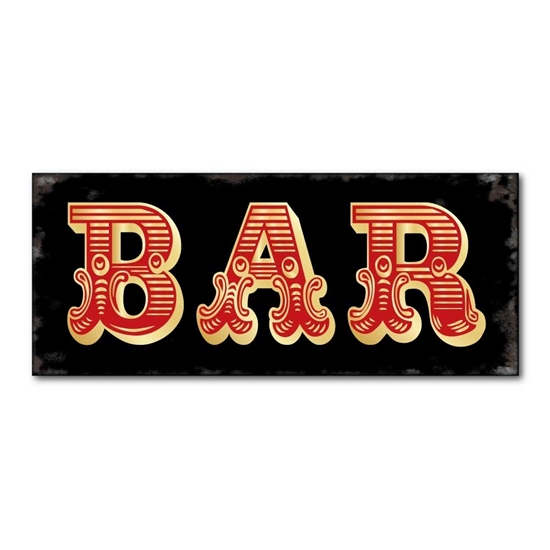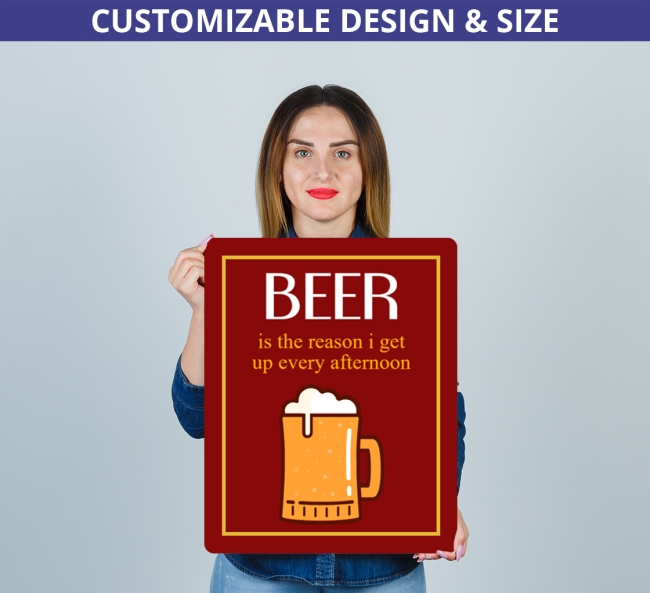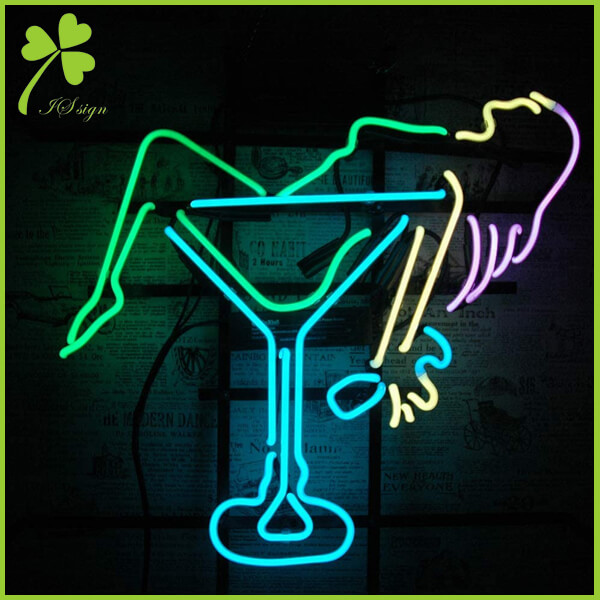Free Tips On Choosing Hanging Signs
Free Tips On Choosing Hanging Signs
Blog Article
What Is The Material Used To Make Signs For Bars?
The materials used in bar signs differ in their materials. They all have their particular advantages and features that can be tailored to suit various designs and needs. This article will provide a brief overview of the materials used for bar signs and their differences. Wood
Characteristics: Natural, rustic, warm.
Durability : The most durable, but susceptible to damage from moisture and.
They can be used for: Name boards, menus and other signage as well as vintage and rustic themed bars.
Customization: The wood can be painted, carved or stained. The possibilities for finishing are endless.
2. Metal
Characteristics: Sleek, modern, industrial.
Durability The material is extremely durable and resistant to weather perfect for indoor and outdoor usage.
Uses: Ideal for use in industrial or contemporary bars, as well as durable informational signs and branding.
Customization Options: Laser-cutting or embossing or painting are possibilities. Often used for intricate designs and logos.
3. Neon
Characteristics: Bright, eye-catching, retro.
Durability It is a bit fragile in comparison to other materials, however it will last an extended time if it is well maintained.
Uses: Perfect to create a retro-inspired ambience, vibrant signs and branding.
Because of the nature of neon tubing, customisation is restricted to outline shapes and texts. Available in various colors.
4. Acrylic
Characteristics: Versatile, lightweight, modern.
Durability: This fabric is resistant to fading.
Uses : For modern, elegant signs. It is also great for illuminated signs.
Customizations: The product may be printed or laser cut. It is also able to be layered to create a 3D look. Available in a variety of colours and styles.
5. Vinyl
Specifications: Flexible, flexible and easy to apply.
Durability - Suitable for semi-permanent and temporary uses. Make sure to use high-quality vinyl so that it's safe to use outdoors.
Uses : Perfect for window graphics and temporary promotions.
Customization: Available in a wide selection of designs, colors and sizes. Simple to apply.
6. Chalkboard
Characteristics: Functional, rustic, interactive.
Durability Maintenance is essential (cleaning and replacement of chalk). If left untreated, they may become damaged.
Uses: Great for menu boards. Also great as interactive signs for places where the information is regularly updated.
Customization - Written messages or designs may be added. Frames can be made of different materials for strength and beauty.
7. Glass
Characteristics: Elegant, sleek, modern.
Durability The material is brittle however, it is able to be toughened. Used with backlighting to create an impressive effect.
Uses: Can be used to illuminated signs, or window signs.
Customization: The item may be painted, etched or printed. Used in conjunction with light to produce a stunning visual.
8. PVC (Polyvinyl Chloride)
Characteristics: Lightweight, versatile, cost-effective.
Durability: Stable and weatherproof ideal for indoor and outdoor usage.
Uses: For promotional events, temporary signage and lightweight branding signs.
Customization options include printing, cutting into shapes and painting. Available in different thicknesses.
9. LED
Characteristics: Energy-efficient, bright, modern.
Durability - Extremely robust and durable. Ideal for continuous use.
Uses: Ideal to create dynamic lighting effects, illuminated signs and contemporary branding.
Customization: Available in a range of colors. Animations or messages can be modified using programmable software.
10. Foam Board
The advantages of this model are that it is easy to carry, light, and easy to handle.
Durability: Not very durable. It is suitable for indoor use.
Ideal for temporary events, promotions and informational signs.
Customization Vinyl can be printed or affixed. Cut into different shapes.
Each material has distinct characteristics that influence bar signs in terms of design, durability, suitability for diverse environments, as well as their use. Picking the appropriate material will depend on the intended use and aesthetic requirements and budget constraints. Take a look at the top rated more about the author about personalised bar signs for site tips including pub wall sign, personalised pub signs for sale, make your own bar sign, outdoor personalised bar sign, garden pub signs, the staying inn sign, make a pub sign, hanging pub signs for sale, personalised beer sign, personalised hanging bar sign and more.
What's The Difference Between Mounting And Installing Bar Signs?
There are various mounting and installing methods for bar signs, based on their weight, size and the location. Here's a detailed look at the various mounting and installing techniques for bar signs. 1. Wall-Mounted Signs
Directly fixed to walls.
Methods:
Anchors and screws Anchors and screws are commonplace for larger signs like metal or wood.
Adhesive Strips are able to be used for small signs (foam boards or acrylics) and temporary installations.
Brackets: They are utilized for signs that need to be able to protrude from the wall for greater visibility.
Uses: Indoor decor, menu boards, directional signs.
Advantages: Secure, versatile, and allows for prominent display.
The drawbacks of this product are: It could damage walls and can be difficult to position.
2. Hanging signs
Characteristics They are suspended from ceilings or overhangs.
Methods:
Chains: durable and adjustable ideal for large signs.
Cables: Modern designs often use cables for their sleeker appearance.
Rods: Provide a rigid support structure.
Uses: Ceiling decor, directional signs, overhead promotional signs.
Benefits: Utilizes vertical space effectively and can be a decorative feature.
Negatives : Needs to be secured using ceiling anchors. Can sway when not stabilized properly.
3. Freestanding Signs
Specifications Not connected to a particular structure.
Methods:
A-Frames are portable and foldable. They are often employed to advertise along the street.
Pedestal Stands: Stable base, ideal for indoor use.
Post and panel: Common for larger permanent signs.
Uses: Outdoor advertising, indoor directional signs, promotional displays.
Benefits: Simple to move, portable, and adaptable.
Cons: It can be very bulky needs the use of floor space.
4. Window Signs
Characteristics: Attached directly to windows directly.
Methods:
Suction cups: Simple installation and removal, perfect for smaller signs.
Adhesive Vinyl can be used for decals or graphics.
Static Cling Non-permanent. Reusable. It is easy to apply and remove.
Uses include: promotional messages, branding, and operating hours.
Benefits: Increases space in windows. Very visible from the outside.
Cons: Limited by size of window, may be affected by sunlight.
5. Signs with backlights and edges that are lit
Characteristics: Incorporate lighting within the sign structure.
Methods:
Wall-mounted electrical connections (Requires safe installation and electrical hook-ups):
Suspended using Power Cables Hanging method and integrated lighting.
Uses for: Menu boards, branding with high visibility and decorative elements.
Benefits: Better visibility, attractive lighting.
Installation is more challenging and requires electrical work.
6. Temporary and portable Signs
Specifications: Designed to be easy set-up and removal.
Methods:
Pop-Up Stands: Light and compact.
Banner Stands: Roll-up or retractable designs.
Uses: Promotions, events Decorate for seasonal events.
Benefits: Simple transport and quick set up.
Cons: It is less durable and may not be as stable.
7. Magnetic Signs
The characteristics of magnetic force are employed to attach objects.
Methods:
Magnetic Strips : The magnetic strips are affixed to signs.
Magnetic Boards. Signs that are attached to metallic surfaces.
Uses: Menu boards and temporary notices.
Benefits: Easy to set up and remove and no permanent fixtures are required.
Limitation to magnetic surfaces can cause it to be less secure.
8. Projection Signs
Features: Project images or texts using light.
Methods:
Mounted Projectors - Securely mounted to walls or ceilings.
Portable projectors can be positioned on stands and other surfaces.
Uses include: dynamic displays as well as events and promotions.
Benefits There is no physical signage is required, and the content can be easily changed.
Advantages
Things to consider when mounting and installing
Weight and Size
Heavy Signs: These signs require stronger solutions for mounting, including screws and anchors.
Light Signs - You could employ less complicated techniques such as suction cup or strips of adhesive.
Durability
Permanent Signs: Choose more secure and durable mounting methods.
Temporary signage: Select techniques that make it simple to move or relocate the sign.
Location
Indoor: Less worry about weather resistance, and greater adaptability of the materials and techniques.
Outdoor: Materials and mounting have to be weatherproof to withstand the elements.
Aesthetics
Concealed mounting: This method offers a cleaner appearance by hiding the hardware.
Decorate with decorative hardware: Improves a sign's look.
Accessibility
Quick Access to Changes for Easy Access It is particularly important for signs, like menu boards, which require frequent updates.
Security: Signs are protected from being easily altered or stolen.
Be aware of these points when selecting the mounting and installing methods to install your bar. You can be sure that these methods are compatible with both functional and aesthetic needs. Read the top rated how you can help about bar signs for home for blog advice including bar signs for home bar, bar signs for home bar, cocktail bar sign, bar sign outdoor, outdoor personalised bar sign, bar signs for home, personalised pub signs for sale, personalised beer sign, personalised hanging bar sign, home bar pub signs and more.
What's The Difference Between Bar Signs And Budget?
Bar signs may vary in cost depending on the factors like size, material, design complexity, customization and the installation requirements. Here are some of the ways that bar signs differ in price. Material Cost
Low-cost Materials: Signs which are made of vinyl decals or foam board as well as basic acrylic are more affordable.
Signs that are made using premium materials like metal, wood, or custom glass can cost more due to material costs and the quality of workmanship.
2. Design Complexity
Simple Design: Signs with simple designs, with no graphics and text, as well as signs that are straightforward in appearance, usually cost less.
Signs with complex designs, custom typography or special effects, such as neon, LED requires more knowledge as well as time. This adds costs.
3. Customization
Standard Options - Pre-designed templates and other off-the-shelf signage options are often cheaper than custom-designed signs.
Customized Features: Although customized branding, logos, and colors add to the cost, they provide unique branding opportunities that are customized to fit your bar's brand.
4. Size and Scale
Tabletop signs, Decals, or Small Wall-Mounted Signs are generally more affordable due to Lower Material and Production Costs.
Large-Scale Signs: Large-scale signs and marquees that are outdoor, as well as illuminated displays need more materials and work, which results in higher costs.
5. Lighting
Non-Illuminated signs: Signs without illumination are usually less expensive because they need fewer components and electrical power.
Illuminated signs: The cost of LED, neon or backlit signage increases because of the additional wires, materials and energy required by lighting.
6. Installation
DIY Installation. Signs made by staff or bar owners are cheaper than those that need professional installation.
Professional Installation: Large or complicated signs could require the services of a professional. This can increase the cost, but make sure that the sign is properly mounted and in to comply with the law.
7. Quantity
Bulk Orders. Ordering multiple signage packages or signs could be eligible for a volume discount or lower unit prices than one-time order.
Single Orders: Ordering single signs or custom pieces can be more costly due to the production and setup costs.
8. Maintenance and Long-Term Costs
Signs That Require Minimal Upkeep: Signs that are low-maintenance and have a longer lifespan can reduce maintenance and replacement costs.
High-Maintenance Signs: Signs with intricate designs, fragile materials, or specialized maintenance requirements may have higher costs to repairs and upkeep.
9. Budget Allocation
Allocated budget: By setting an appropriate budget bar owners will be able prioritize the expenditure of their signage on elements such as visibility, branding and long-term durability.
Cost-Benefit Analysis: Analyzing the ROI (ROI) of different signage options can help bar owners make informed choices about how to allocate their budget for the greatest impact.
Financing Options
Upfront Payment: Paying upfront for signs is more cost-effective than financing them through loans or installment plans. This will save you finance charges and interest costs.
Financing plans: Some sign makers provide financing or payment options for spreading the cost of their signs across time. This makes higher-end signs more affordable for bar owners who have limited capital up front.
Be aware of these elements when making your choices within your budget when choosing signs that improve customer experience, communicates your brand identity and enhances the value of your business. Have a look at the most popular hanging bar sign info for blog recommendations including home bar pub signs, personalised garden pub sign, bar hanging sign, hanging pub signs for garden, the staying inn bar sign, personalised cocktail sign, large personalised bar signs, personalised pub, bar sign outdoor, outdoor personalised bar sign and more.